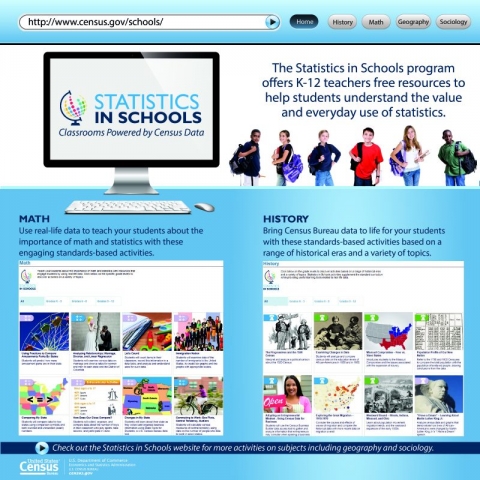Sep072016
Posted at 11:35 AM
Post by Nancy Potok
As many kids across the nation go back to school this month, we are excited to roll out a new U.S. Census Bureau program, “Statistics in Schools,” aimed at making a real and positive difference in American education.
Statistics in Schools offers teachers and students a free toolbox brimming with comprehensive statistical information to enrich the K-12 academic experience.
In 2010, Census in Schools, the forerunner to Statistics in Schools, showed us the importance of educating America’s youth about statistics. We are excited to unveil a new evergreen program that will last between each decennial census. Statistics in Schools has the richness of its predecessor but carries forward all of the work, energy and time invested in developing a trove of valuable educational materials.
The new website provides data, tools and teacher-friendly activities to K-12 educators in math, history, and social studies as well as the newly added subjects of geography and sociology. We also doubled the number of tools on the website; resulting in more than 100 resources from which teachers can choose, including:
- Maps and historical documents — historical and current maps as well as photos, cartoons and census records.
- News articles — examples of census data applied to current events in the news. Videos — the importance of statistics and how data relates to students today.
- Games — test your students’ knowledge in our population bracketology game.
- Infographics and data visualizations — census data presented visually; many linked to a classroom activity.
- Searchable data tools that reveal population statistics by sex, age, ethnicity and race.
- Activities organized by grade, education standard and subject.
- Information to help teachers explain the Census Bureau to students.
To develop the program, we assembled subject matter experts from the American Statistical Association, the National Geographic Society, the National Council of Supervisors of Mathematics, the National Council of Teachers of Mathematics, and many others to vet and evaluate Statistics in Schools materials. Our first road test yielded a wealth of information on how we could further strengthen the program — teams of more than 350 teachers from across the country, along with experts on subjects and standards, pointed to improvements that would make Statistics in Schools even more useful. The program is now ready for prime time.
The next step in the program is perhaps the most exciting, as educators throughout the nation begin to leverage Statistics in Schools to enrich their curricula. I look forward to being on this journey with you and working toward improved statistical literacy for the next generation. Please stay in touch — we will be listening closely to learn what works, what could be improved, and how the Census Bureau can continue to help you.



